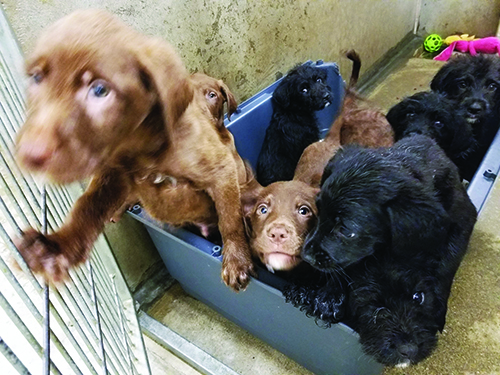Puppy Mills and the Inadequacy of the Animal Welfare Act
Here’s something that all of us can agree on: No one should ever buy a puppy from a puppy mill. Puppy mills are horrific and should be put out of business.
An estimated 2 million puppies are “produced” annually in puppy mills in the U.S. Since the number of dogs who are euthanized by shelters in this country every year is estimated to be 1.2 million, you can see why simply shutting down puppy mills is such an alluring idea to those of us who have worked in shelters. But it’s difficult to put an end to any practice that some people profit from, no matter how cruel it is.
That’s why we try to educate people – to make sure they understand, first of all, that any “purebred” or “designer-mix” puppy that’s for sale in a pet shop has been produced by a puppy mill, no matter what the store employees have been told to say.
We also try to make would-be buyers understand that when they pay for a puppy from a pet store, they are directly supporting canine suffering at the hands of all the shady breeders, brokers, and scammers that supply pet stores.
Most of us have seen photos and videos taken by animal protection groups following a raid on the worst kind of puppy mill, where the living conditions of the dogs are unspeakably horrendous, with cages crammed with sore-covered dogs stacked on top of more cages, and all of them full of filth. No one would argue for ”businesses” like this to be allowed to continue operation.
It’s much more difficult to recognize the cruelty of puppy mills that advertise how many veterinarians they have on staff, discuss their healthcare and socialization programs, and display pictures of shiny-clean facilities alongside their United States Department of Agriculture (USDA) licenses. The conditions look better – but their breeder dogs are still puppy-producing machines who have no semblance of quality of life. And the puppies will be sold to anyone willing to pay for them and shipped anywhere in the country at too-early ages.
The bottom line for mills is that puppies are simply “products” – and the puppy miller’s bottom line will always be more important than the welfare of the dogs.
The USDA’s Animal Welfare Act (AWA) establishes legal requirements for the care, handling, housing, transportation, and sale of animals at licensed breeding facilities. Puppy-millers and their downstream co-conspirators like to claim that their USDA licenses and unannounced AWA compliance inspections keep the industry honest. But the reality is, these laws are woefully inadequate. For example, under the AWA:
• There is no limit to the number of dogs on the premises. A puppy mill could have hundreds or even thousands of dogs.
• There is no minimum requirement for the number of staff that must be available to care for the dogs.
• Dogs may be kept in stacked cages.
• Mesh or wire flooring is allowed.
• Dogs may be forced to relieve themselves in their cages.
• Dogs may be confined in spaces only six inches longer than their bodies, not including the tail.
• A dog may be caged 24 hours a day for his or her entire life, only removed from the cage to be bred.
• There is no exercise requirement if dogs are housed with other dogs and minimum size requirements are met for the dog’s enclosure.
• Dogs can be housed indoors or out with minimal temperature regulation.
• Human interaction is not required.
• Breeding females at the first heat cycle and every heat cycle thereafter is permissible.
• Unwanted animals may auctioned off or killed in a variety of ways.
• There is no transparency to consumers or the public about the results of USDA inspections.
And finally, it should be obvious that the USDA can’t adequately inspect the entire puppy mill industry; currently there are only an estimated 110 inspectors on staff to inspect all the animal facilities under its supervision, including zoos and research labs, in addition to commercial dog breeders and brokers.




